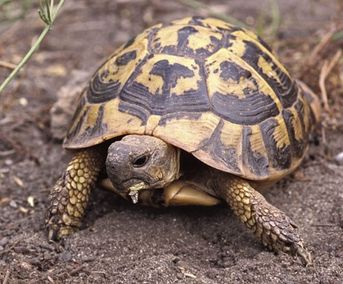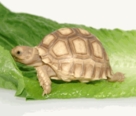Hermans Tortoises (Adult) - Testudo hermanni

Hermanns Tortoise, also named Testudo Hermanni, is a small to medium sized tortoise which does not exceed 25 cm in length and weigh up to 2 kg only. This species also has two sub species which are named The Eastern Hermanns, found in Serbia, Macedonia, Romania, Bulgaria and Greece and The Western Hermanns, found in eastern Spain, southern France and Central Italy. The carapace is domed shaped and is distinctly colored in yellow-orange with bold black markings. The head is either brown or black in color and often there are yellow spots on each side of the head. Upper jaw is a little hooked and like other tortoises, possesses no teeth; only a strong, horny beak does the wonders. The tail ends in a horny spike and the scaly limbs are greyish to brown in color. A well-developed spur and a thick and long tail distinguish male Hermanns Tortoise from females. They are very active in nature especially in the mornings and late afternoons. Their activities include running, hunting, digging, climbing, sun bathing, hiding etc. During the time of mating the males become all the more aggressive and inflict nasty bites on females. Breeding takes place in April or May. Female lays up to 13 eggs and this is done on land after making a pit. They can live approximately for 70 years. Males reach their sexual maturity in their eighth year and females in their eleventh year. The biggest threat to their life is from birds but only till the time they are young, as adults, fire and man become danger for them.
The Hermanns Tortoise Habitat
Mediterranean oak trees, rocky hillsides and pastures are such places where Hermanns Tortoises can be found. South facing slopes, edible weeds and profusion of low lying shrubs are the main reasons of finding them in such areas. Their natural habitat is filled with rocks, logs, grasses etc. which gives them the scope of climbing and creating spaces for themselves to hide and seek shades. Wooden vivarium is recommended when it comes to keeping Hermanns in captivity. Temperature should be kept between 90 and 95 degree Fahrenheit with the help of spot bulb. UVB light is also required to help tortoises synthesize vitamin D. Beech woodchip can be used as a substrate. Keeping in mind the intensity of their activity, a decor to climb upon should be provided. Artificial plants can be used to lighten up the vivarium.
The Hermanns Tortoise Diet
While living in wild, they consume various kinds of weeds and flowers like vetch, clover, dead nettle, hibiscus, pansies etc. When in captivity remember to feed them those food items which are rich in fiber and low in protein. Salad consisting of shredded carrot, kale, pumpkin and endive will prove very healthy. Fruits should be avoided because their digestive system cannot process it. A calcium supplement is essential which are easily available in pet stores in form of powder. Cuttle bone is a good source of calcium and they can gnaw at it till the time they are satisfied.

Before Placing Your Order
Store InformationShipping Info
Payment Info
Return Policy
Arrive Alive Guarantee
Adoptation Policy
After Placing Your Order
Track Your OrderSecurity Safe Shopping
Compatibility Chart
Shoppers Review









